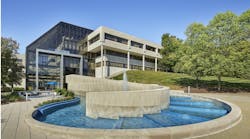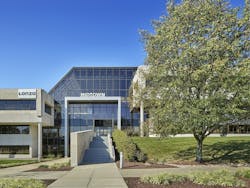Before COVID-19, indoor air quality in office buildings was an important, but generally downplayed issue. It was well-documented that air quality contributes to germ proliferation, and that purer air facilitates clearer thinking and higher productivity.
And, while advanced air quality monitoring was accessible pre-pandemic, the technology required was expensive. Often, during new construction and tenant buildout discussions, budget constraints resulted in air quality measures designed to meet or narrowly exceed standards set forth by industry regulations.
The COVID-19 pandemic dramatically and urgently altered this landscape by introducing an entirely new set of concerns and guidelines to the workplace. As a result, office assets across the country are receiving upgrades that deliver cleaner, safer and more comfortable air than ever before.
[Related: The Role of Technology in Post-COVID Spaces]
Why COVID Management Leads to Cleaner Air at Work
Commercial building owners and operators are experienced with the details involved in managing indoor air quality. From regional implications to numerous industry and government regulators, criteria were relatively stable and predictable.
The onset of the COVID-19 caught just about everyone across the country and across the world by surprise. The pandemic is rapidly changing the public health, legal, regulatory and social landscape. The CDC recently updated its guidance on ventilation, urging a layered strategy. The consensus is clear that COVID-19 appears to be an aerosol disease, and technology and system upgrades are happening where operators want to monitor inside and outside air.
At Keystone Property Group, we are installing MERV 13-rated filters in our HVAC systems that are nearly twice as thick as most filters previously used throughout the industry and are efficient at capturing airborne viruses. The thicker filters often require increased air pressure to move air through units and won’t fit in many older HVAC units, but are a solid first step toward mitigating the spread of the virus.
At our APX property in Morristown, New Jersey, we went a step further by installing a bipolar ionization system. Integrated into HVAC systems, the technology takes oxygen molecules from the air and converts them into charged atoms that surround and deactivate harmful substances like airborne mold, bacteria, allergens and viruses.
In addition, the charged atoms attach to expelled breath droplets and dust particles, enlarging them so that they are more easily caught in HVAC filters. It is an active process that provides continuous disinfection and can reduce 99.9% of microbes in a matter of minutes.
The installation of this technology means that Keystone, and like-minded operators, won’t have to open our buildings to excessive outside air or alter building criteria to clean or “change” air quality. And while it comes with a hefty price tag, this and similar technologies are likely to provide comfort to existing occupants, as well as attract new tenants moving on from less agile office buildings.
How COVID Has Changed Sustainability in Commercial Real Estate
Before COVID-19, sustainability in commercial real estate was primarily about saving energy and water, access to public transportation, and environmental and carbon footprints. Sustainability was always a part of health and wellness, just not the focus.
The pandemic accelerated that conversation. Now, true sustainability occurs when buildings become more flexible and adaptable to accommodate the needs of occupants.
In July 2020, the United States Green Building Council released six LEED Safety First pilot credits outlining sustainable best practices related to cleaning and disinfecting, workplace occupancy, HVAC and plumbing operations, and pandemic preparedness and response. This demonstrates just how intertwined sustainability is with health and wellness.
[Related: COVID-19: Are Building Managers Measuring the Right Air Quality Parameters?]
When Workers Come Back to the Office
All of us in commercial real estate are trying to predict the future as it relates to post-pandemic work environments. It’s safe to say, many people want to get back to the office, where homes are overrun with challenges like virtual schooling or childcare.
Most successful companies also thrive on socialization and collaboration. Of course, a to-be-determined percentage may work from home in perpetuity now that it has been proven possible. Work will likely evolve into a hybrid environment with built-in flexibility.
How much de-densification will the office market experience? Rather, how much can it withstand?
Answers will depend on how developers and owners respond to air quality issues. You can’t call your office building Class A if you’re not making these upgrades. And it’s about more than investing money. Commercial real estate developers must educate building occupants about these new safety requirements and comfort features.
Tenants will not see air being ionized. They won’t hear thicker filters cleaning HVAC systems. They won’t know the CO2 levels in the air they’re breathing are within an ideal range. But with transparent communication, awareness and the right marketing strategy, occupants of buildings with better air quality will ultimately feel safer and work more productively as a result.
About the Authors:
Joseph Dyer is the Regional Property Manager for Keystone Property Group. He is responsible for overseeing Keystone office properties in New Jersey. Tom Sklow is Vice President of Development & Leasing at Keystone Property Group and is responsible for overseeing Keystone’s New Jersey properties, as well as 1K1 in Conshohocken, PA.
Read Next: COVID-19: What You Need to Know About Air Filters





